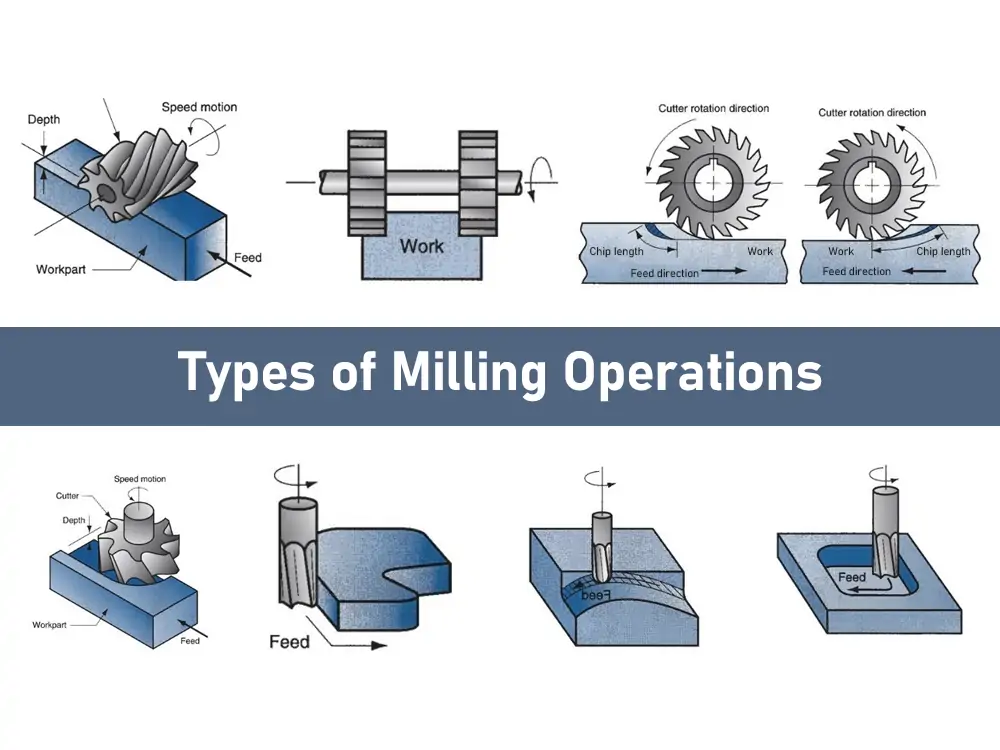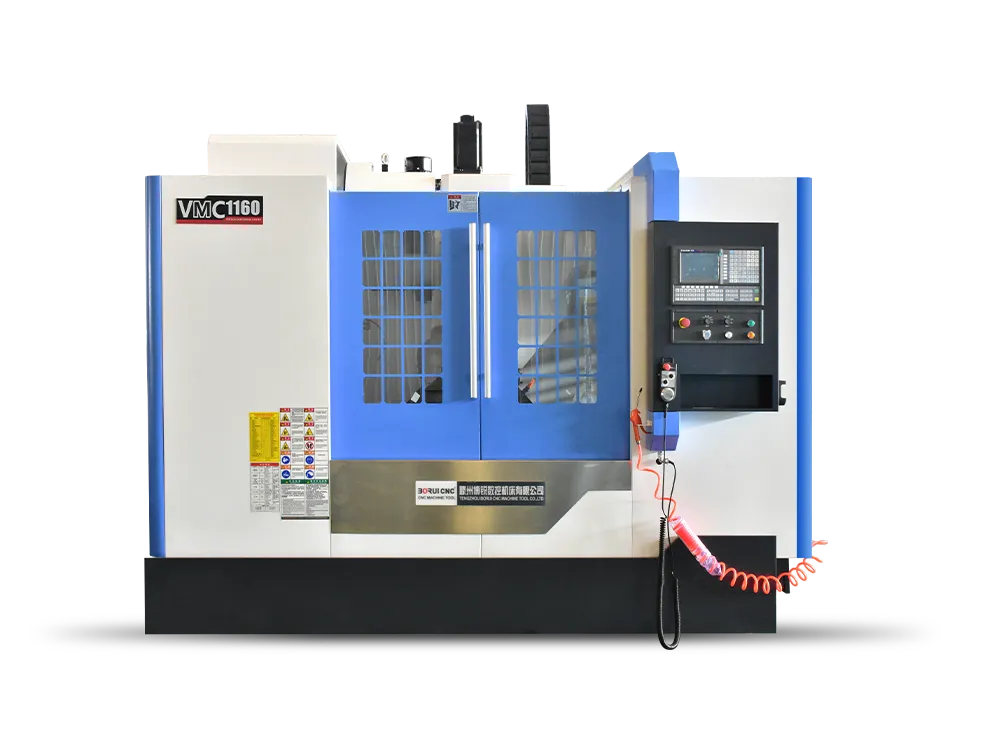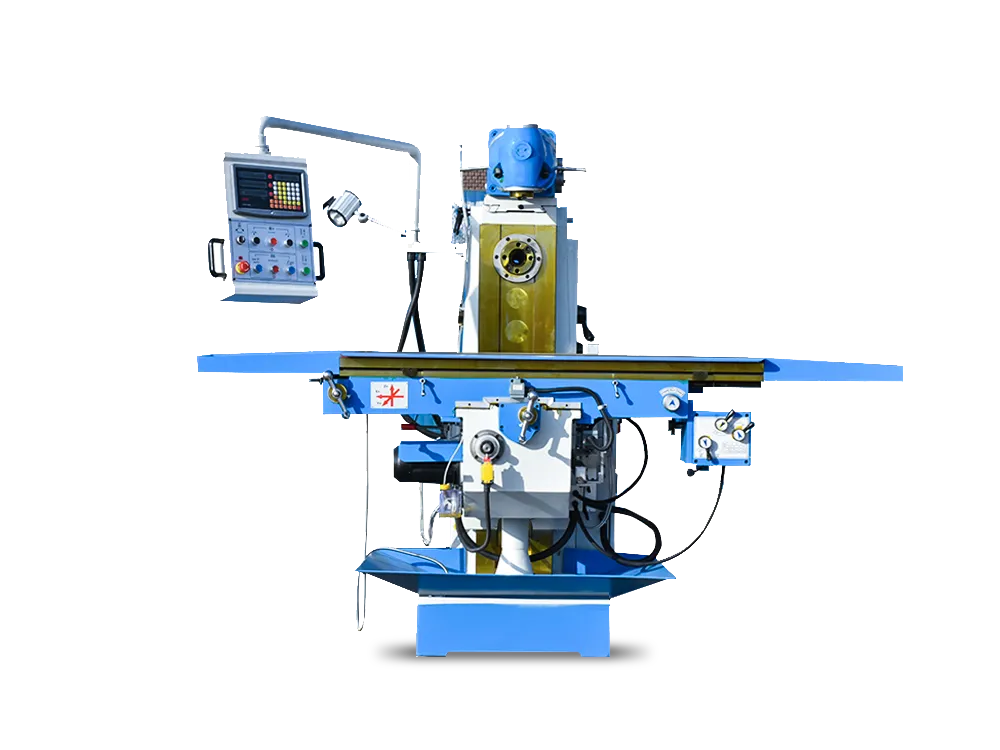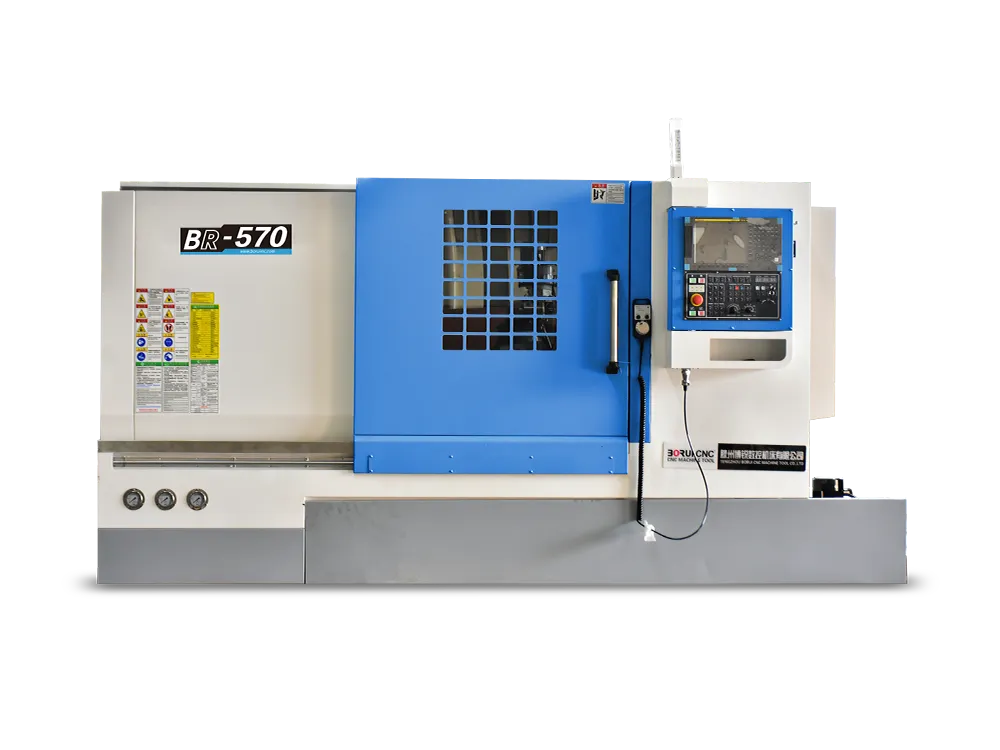
You see various shapes of different materials, such as plastic, metal, and wood. But have you ever wondered how those complex shapes are created? Milling is the science behind them. However, milling is not a single process; several milling operations exist. Each type uses definite tools and techniques.
Therefore, those types vary in many aspects. Knowing those types is crucial whether you are a simple machinist or a skillful engineer. Running those operations without their knowledge can cause unwanted results. Are you also unfamiliar with those milling types? Fret not! In this article, I will explore common types of milling operations. So, let’s get started!
What are Milling Operations?
Milling operations are machining processes that remove material from a workpiece. Simply put, milling operations shape and cut different materials. These operations use modern technology to ensure precision while cutting. From simple to complex, you can achieve any shape with milling.
However, these simple-looking operations do not work straightforwardly. They use various tools for their efficient working. Those tools involve cutters, drills, and slots. Let’s discuss how these tools shape the material. The workpiece is placed on the stable platform, and the tools are connected with a rotating arm.
These rotating tools move around the workpiece from different angles and cut it. However, these tools are highly customized. For example, they cut the material from the desired angle and depth. So, these operations are very advantageous for creating complex geometries. For instance, they are used to make frames for aircraft and ships, etc.
Types of Milling Operations
As said above, the milling process is not simple and has many types. Those milling operations vary from each other in many ways. In the upcoming section, I will discuss various types with their detailed insight. Let’s dive in!
1- Face Milling
Face milling is one of the versatile milling operations. Face mill cutters are used in this operation. Those cutters have several cutting edges on the face and edges. So, how do face cutters work? The workpiece is kept perpendicular to these cutters.
The cutting edge present on the face removes a large amount of material from the workpiece. However, the corner cutting edge smooths the surface of the workpiece. This way, you get the material with the desired shape and smoothness. Due to several cutting edges, the face milling operation is speedy. Therefore, it is used in the aerospace and oil and gas industries.
2- Plain Milling
Plan milling is another vital milling operation. This operation creates a flat surface on the workpiece. This flat surface is the base for further advanced machining procedures. The tools used in this milling are slab cutters. This is the reason plain milling is also known as slab milling. These cutters have sharp teeth that remove significant material in one pass.
Moreover, several types of cutters depend on the spacing between teeth. Plain milling is an energy-efficient operation due to the use of simple tools. Therefore, it is best suited for machining jigs and creating flat surfaces on metals. But remember that this type is time-consuming and does not create a surface with fine finishing.
3- Side Milling
As suggested by the name, this milling operation removes material from the sides of the workpiece. The cutters used in this operation are milling cutters. These cutters have cutting edges across the circumference. These cutters move along a parallel axis to the workpiece during the cutting process. Therefore, this milling is best suited for creating slots and grooves in a workpiece.
You can perform this operation in two ways. For instance, the cutter moves and cuts against the cutting path( conventional milling). Either the cutter moves with the cutting path( climb milling). In the second case, you get a more finished surface. Lastly, the correct setup of tools and workpieces improves side milling precision.
4- Straddle Milling
Straddle milling is an advanced milling operation. This type uses two milling cutters that work simultaneously. HOW? Let me explain how they work. An arbor connects two cutters. Those cutters move on a parallel axis and cut two different surfaces simultaneously. Thus, this operation helps create identical shapes or designs, such as slots.
The arrangement of cutting edge on these cutters is peripheral. It means they remove the material quickly. In straddle milling, the position of workpieces matters a lot. If you aim to create symmetrical slots or grooves, then the position of both surfaces should be identical. Moreover, you can adjust the depth and size of grooves by adjusting the distance of cutters.
5- Gang Milling
Do you want to perform several milling operations at one time? Gang milling offers you this facility. Gang milling uses several cutters arranged at the same arbor. Those cutters perform different milling operations on the same workpiece simultaneously. For example, some cutters create slots and flat surfaces on the workpiece.
You can change the configuration of these cutters and get your desired shapes. You may get worried that several operations at the same time may compromise on precision. But this is untrue. All those cutters work with an automated system and create intricate and precise shapes. Gang milling is mainly used in the electronic and aerospace industries.
6- CAM Milling
CAM milling is the most advanced type of milling operation. It uses Computer-Aided Manufacturing (CAM) software. This software directs all the cutting tools and creates the most complex and precise designs. But how does this software work? The procedure begins by making a digital model.
This model is made using another software called CAD (Computer-Aided Design). The CAM software processes this design and creates specific toolpaths. Those toolpaths are then converted into G-coding, which controls CNC tools. CNC machines follow those instructions and cut the workpiece precisely.
Quick Highlight: This operation is completely computerized, so there is no chance of human error. The computerized system follows the programmed instructions (made using CAM software). Due to this, I consider this type of milling to be one of the more precise types.
7- End Milling
End milling is another manual operation that creates slots and pockets in a workpiece. The tools used in this milling are known as end mills. The end mill has a specific design with cutting edges on both the face and sides. Thus, it can efficiently cut the material from different angles, i.e., horizontal, diagonal, and vertical.
However, end mill tools are versatile and come in different types. For example, flat-end mills, ball nose, and corner radius mills are some types. All those types are specific for plastic, wood, and metals. Due to advanced technology, now end milling also has a CNC system.
Quick Highlight: You should know that end milling produces significant heat. This heat can cause tool wear and tear more quickly. Different coolants are available to reduce the heat effect and remove this issue. Manufacturers generally use these coolants when working with end milling.
8- Saw Milling
Sawmilling is the traditional type of milling operation. In this operation, saw milling cutters are used. Those cutters have sharp teeth at the sides and remove material from a workpiece. Saw cutters are arranged with an arbor that holds them tightly during milling. However, the speed of saw cutters can be controlled manually.
By saw milling, you can obtain low-depth slots and grooves. Therefore, it is best for creating grooves in machine parts and jewelry. Moreover, due to its traditional design, this operation is overall cost-effective. Hence, it is a good choice for small workshops. However, the heat build effect is also prominent in this operation. However, you can use a coolant to resolve this issue.
9- Thread Milling
Thread milling is a CNC operation. This operation involves tools known as thread mill cutters. This milling lets you obtain threads of different shapes and sizes on the workpiece. HOW? In this operation, the thread cutter moves in a spiral path controlled by the CNC system.
That cutter removes the material from the workpiece in the form of layers. As a result, threads of desired shapes and depth are created. These cutters can move in all axes. So you can obtain threads in any direction without additional tools. Due to the higher level of precision, it is used in making aircraft and electronic parts.
10- Form Milling
Form milling is a unique type of milling operation that creates contours. In this operation, predefined cutter shapes, known as “form cutters,” are used. Those cutters create definite contours on the workpiece. In simple words, the shape of the contour is decided by the shape of the form cutters used.
This operation begins by choosing the cutter’s shape. The workpiece is placed on a stable platform. The form cutter rotates on the horizontal or vertical axis and removes material from the workpiece. This operation also uses CNC-controlled form cutters, so precision is not compromised. Form milling is used in gear manufacturing, molds, and dies.
Different Types of Milling Operations Based On Milling Mechanisms
All the above types of milling operations were based on the tools used. But do you know that milling can also be divided into other types based on the milling mechanism? In the section below, I will explore those types briefly.
1- Manual Milling
Manual milling machines used traditional tools and methods. Skillful operators manually drive all those tools. This milling procedure uses spindle, handwheel, table, and cutting tools. How do all those manual tools operate? Let me explain it. On the table, a workpiece is placed, and it may be stationary or rotating based on the milling operation.
The spindle is the rotating tool that helps the table or tools move during milling. When the operator drives the handwheel, the spindle moves, and cutting tools cut the material. However, the operators control the speed of all those tools. It would not be wrong to say that the precision of shapes and cuts depends on the operators’ skill.
2- CNC Milling
The most advanced milling mechanism is CNC ( Computer Numerical Control) milling. In this milling procedure, machines that shape or cut the material are automated. HOW? First, a digital model of the design is created using CAD/CAM software. This model is then converted into G-code. A computer decodes these instructions and directs the cutting tools.
Cutting tools cut, shape, and create intricate designs without mistakes. Moreover, CNC tools can move in three, four, or five axes. This means most complex geometries are possible with this mailing. As humans do not contribute, the precision level is excellent. This advanced milling has become a necessity of industries where precision is key.
3- Conventional Milling and Climb Milling
Conventional and climb milling are two opposite milling operations. Let me explain their mechanism in simple words. Conventional milling is also known as up-milling. In this milling, cutters move against the feed direction. If the workpiece moves in the down direction, the cutter moves upward and removes material from the workpiece.
The chips (removed part) can be both thin and thick. This type is suitable for machining more complex materials such as aluminum and steel. However, due to the opposite cutting direction, the action of friction is significant. Friction produces heat, which causes wear and tear of tools. Moreover, the finishing in this type is very poor.
Climb or down milling is the opposite of the above milling mechanism. In this procedure, cutters move with the feed direction. If the workpiece moves down, the cutters also move and cut the workpiece in this direction. The chips of a workpiece are thick earlier and become thin milling proceeds. Moreover, the heat buildup is also less in this type.
Milling Operation Applications
Milling operations are not just about cutting materials. They’re about innovation, precision, and many other things. Are you curious about how milling operations are serving us? The section below explores their applications.
1- Aerospace Industry
The aerospace industry never compromises on precision. A slight mistake can lead to serious results. So, milling is trustworthy here. You see the complex geometries of aircraft. For instance, aircraft engines, fitting frames, and panels are created by CNC milling. This automated milling operation uses a computerized system and creates different parts precisely.
2- Automotive Manufacturing
The automotive industry also uses several milling operations. For example, milling creates intricate and modern vehicle frame designs. Milling is also helpful in making the engine’s heads, gears, and valve components. All those parts work efficiently due to the accurate geometries obtained by milling.
3- Tool and Die Making
Another application of milling is in tool-making industries. For example, dies used in stamping and cutting are manufactured by milling. Moreover, the molds used in plastic injection molding are also prepared by milling operations. The precision of those tools is necessary for their efficient working. So, milling operations give them a higher level of precision.
4- Woodworking and Furniture Manufacturing
Milling is not confined to metals and plastic. Milling operations also produce various intricate designs and shapes of wood. For example, furniture-making industries use milling machines to create elaborate and modern shapes. Moreover, wood art in architecture is also a result of milling operations.
5- Electronics and Semiconductor Manufacturing
Electronics require lightweight metals and semiconductors for their production. These materials require special attention when working with them. Thus, milling machines are used to handle these materials. You see various electronics such as refrigerator frames, heat sinks, and connectors. Milling operations prepare all those.
Frequently Asked Questions
Which type of milling operation achieves the highest accuracy?
CNC milling operations achieve the highest accuracy. This is because they use a computerized controlled system. This system is automated and directs the milling tools to cut the material. Hence, the chances of human errors are zero, and you can achieve the highest accuracy.
Which type of milling operation is the most cost-effective?
Manual milling is the most cost-effective operation. The reason lies in its simple driving mechanism and tools. Those tools are operated manually and do not require higher skills. But keep in mind that precision is compromised in this type.
What materials are suitable for milling operations?
Milling operations can handle several materials. The list of some of those materials includes
- Stainless steel
- Plastic
- Woods
- Aluminum
- HSS (High-Speed Steel)
Conclusion
Milling operations have various types and are used for multiple purposes. For example, some create simple grooves, and some create intricate and complex geometries. Those types include face milling, plain milling, end milling, saw milling, etc.
Other milling mechanisms exist, such as CNC, manual, and conventional. CNC is one of the most advanced types. Milling has become a necessity of modern industries due to its precision and versatility. For instance, milling machines are used in the automotive, aerospace, and metalworking industries.




